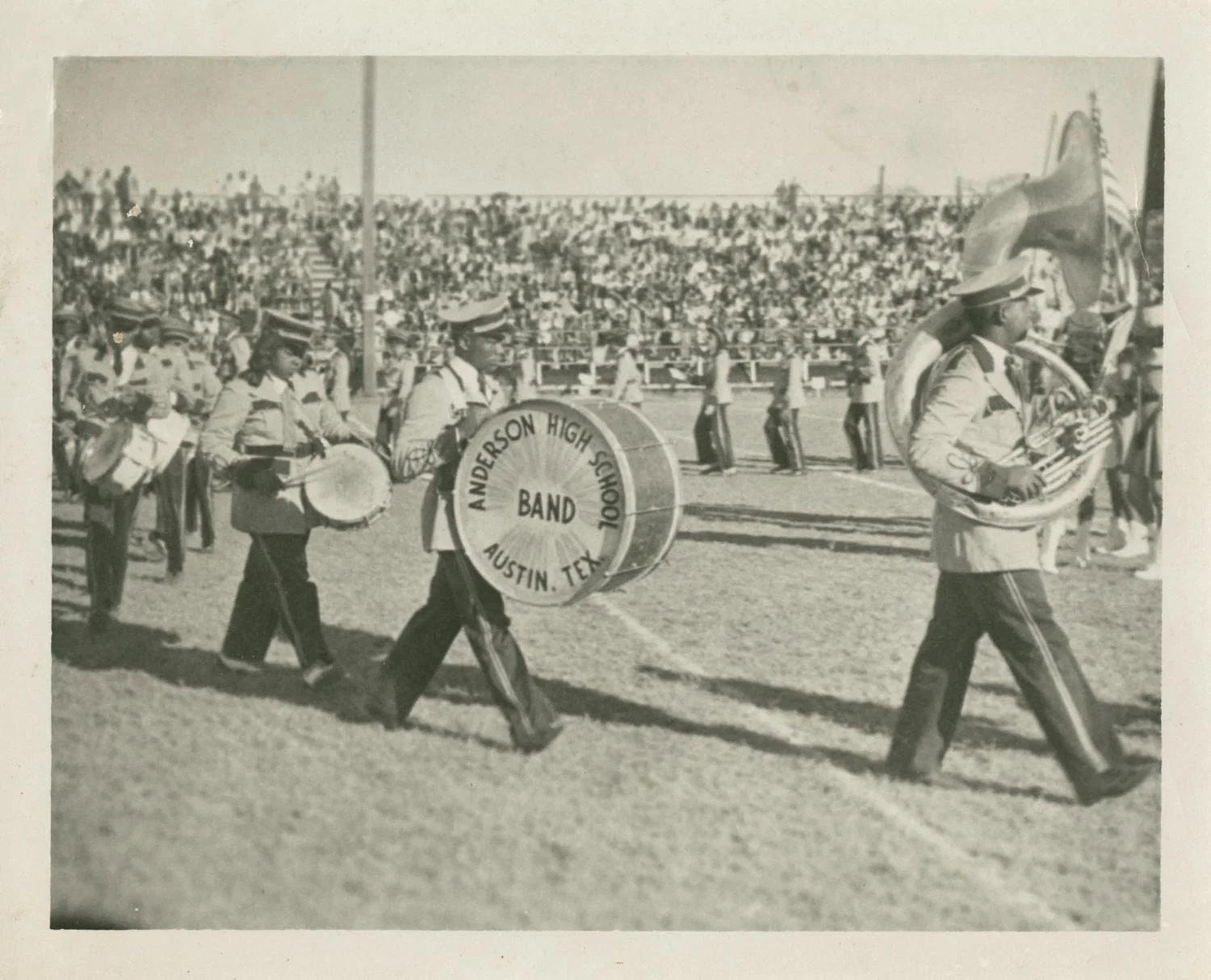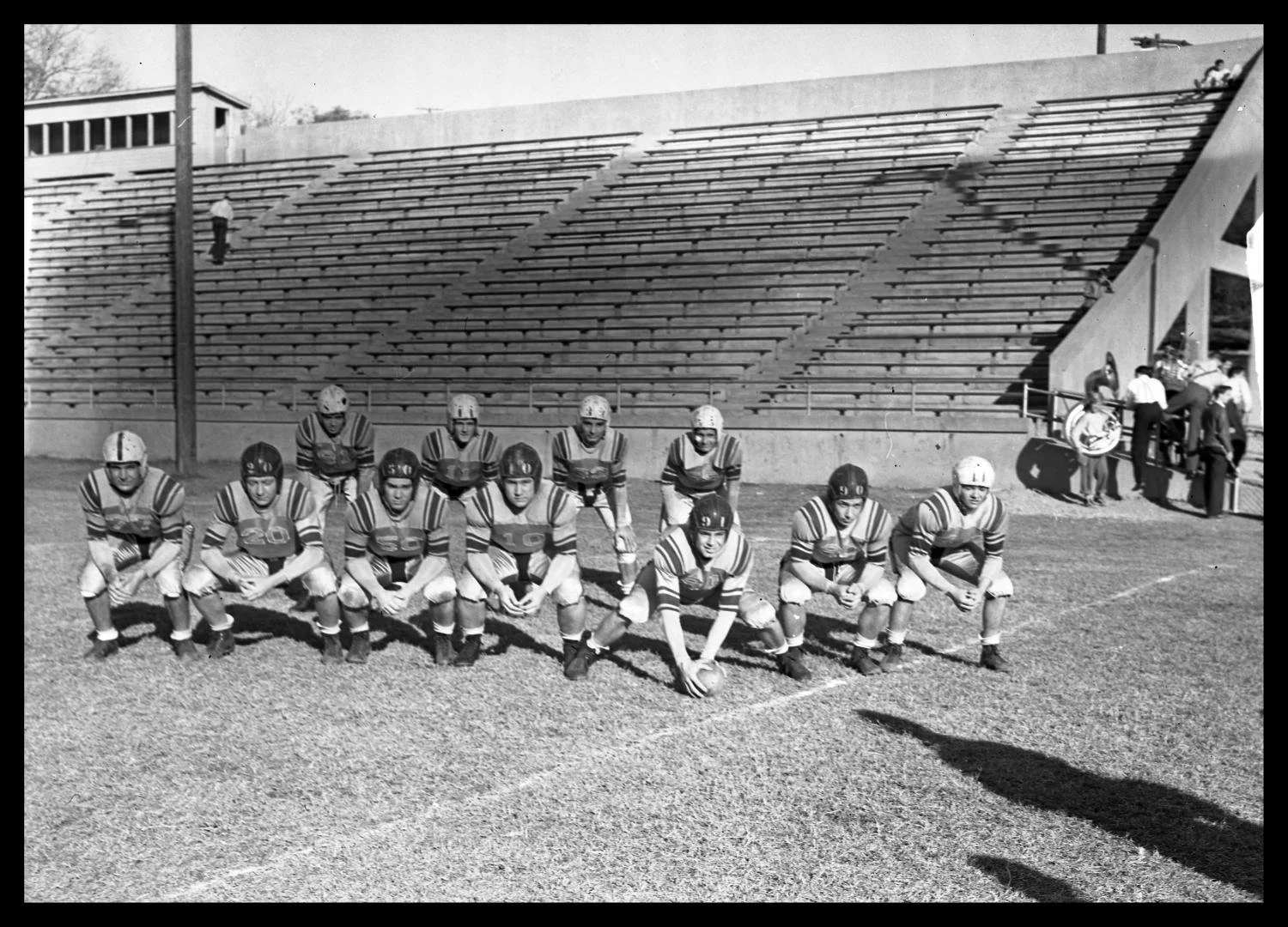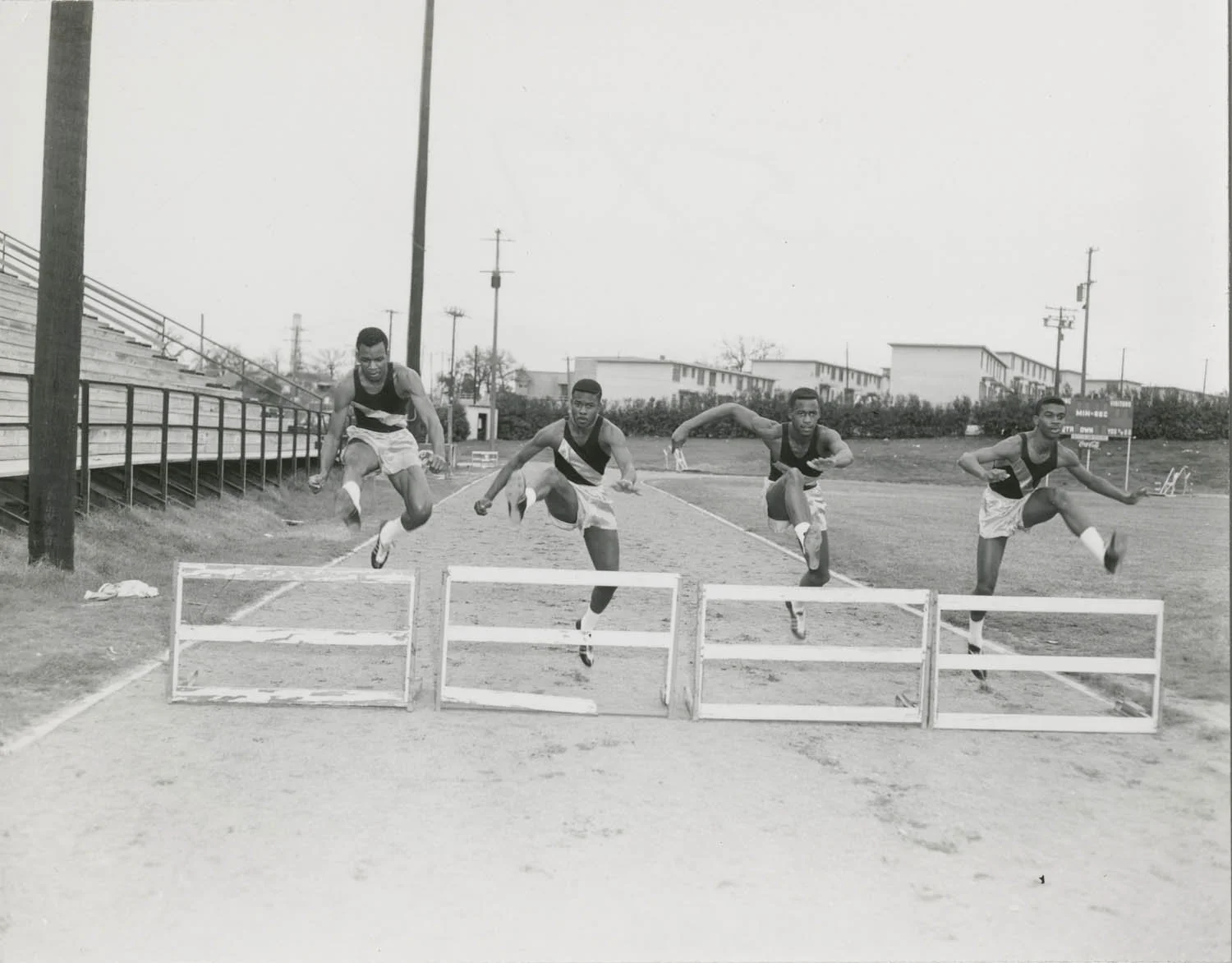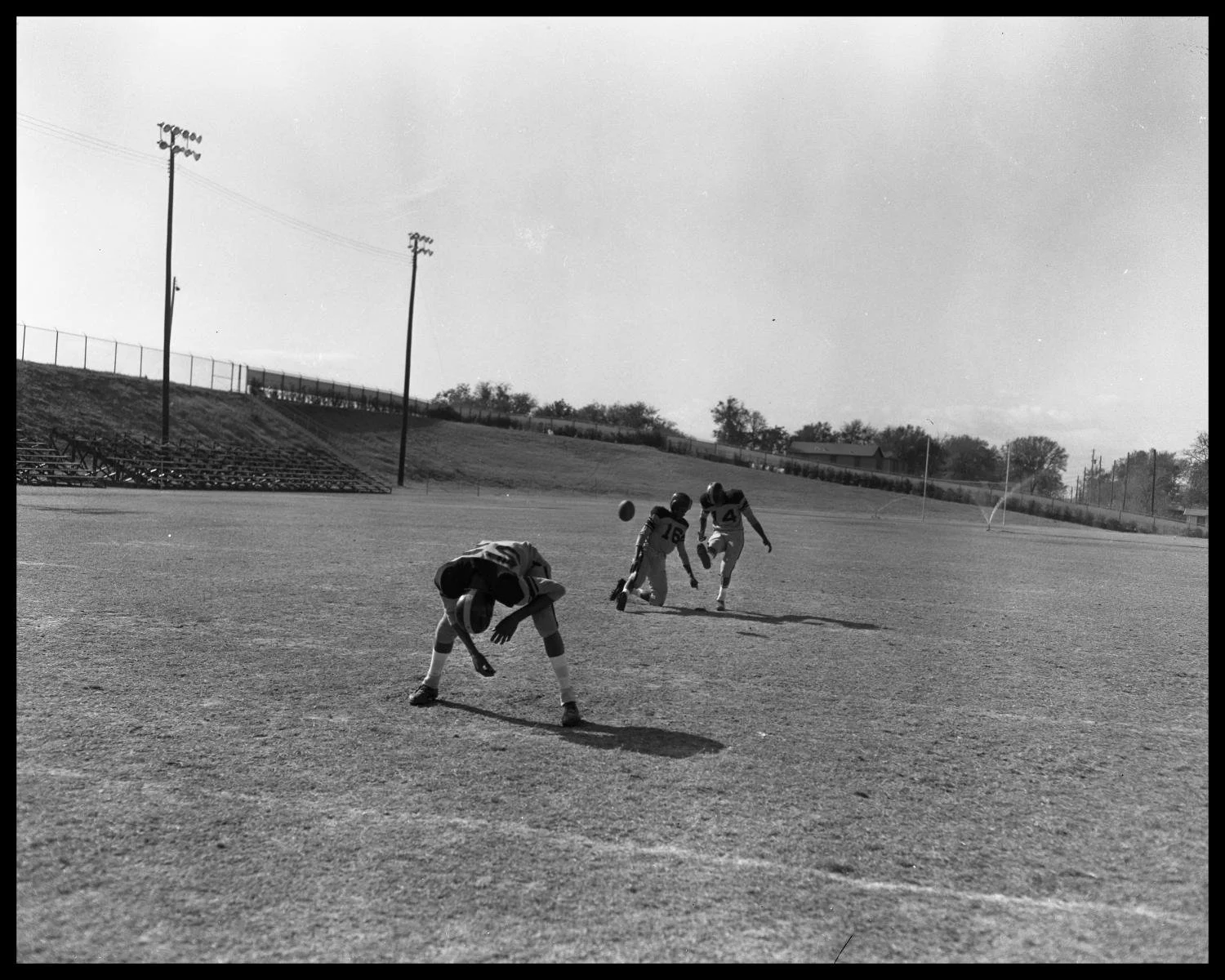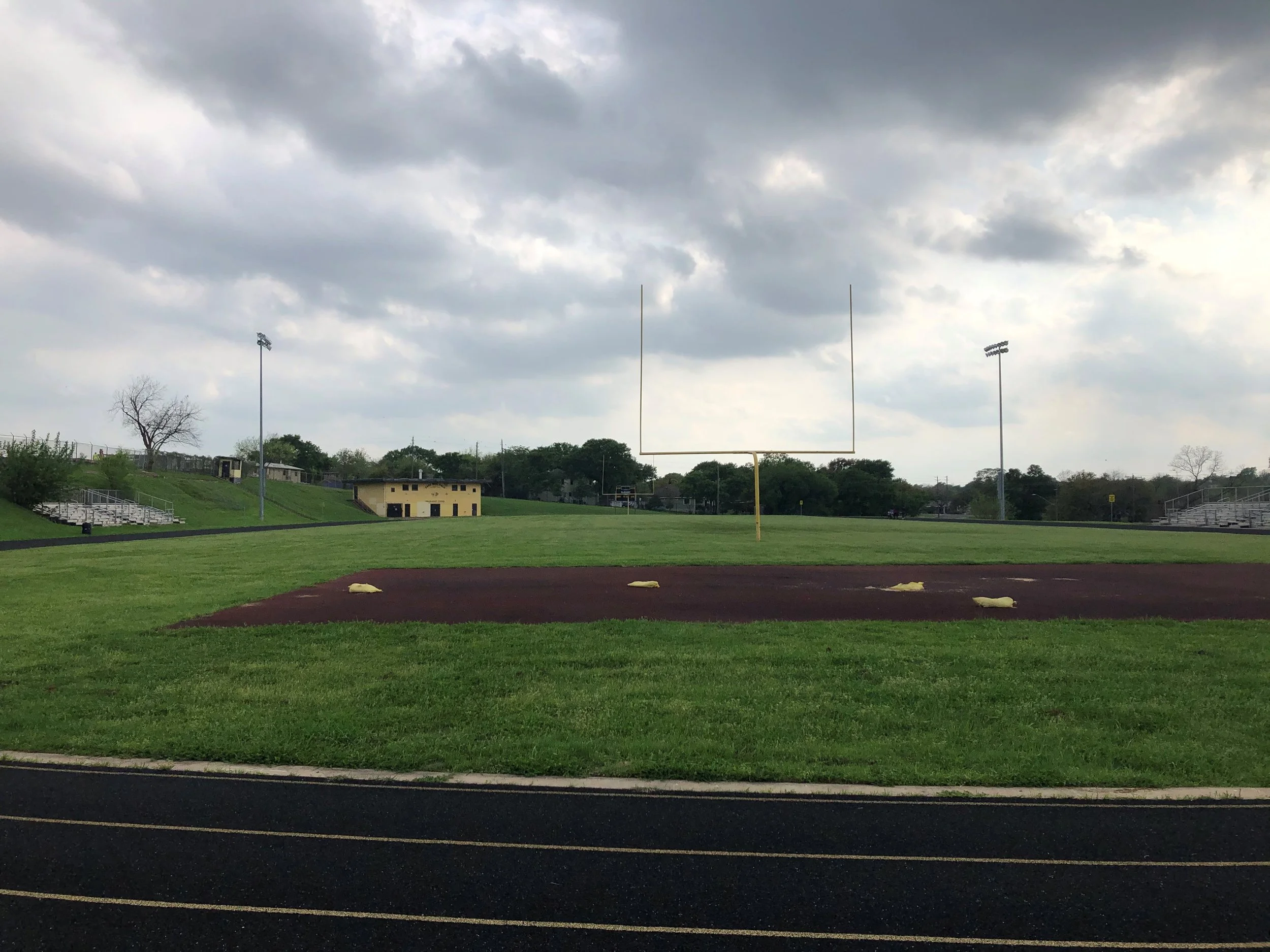Home to Champions: Anderson Stadium in East Austin
BY REBEKAH DOBRASKO
This article, originally published in the fall of 2021, is the third in a series of Preservation Austin newsletter articles about Old L.C. Anderson High School. Read our complete series here.
The award-winning Yellow Jacket Marching Band performs on the field.
With fall comes Texas’ national sport—football! While high school football has been played in Austin for almost a century, most think of large stadiums like House Park and Nelson Field as the home of high school football in Austin. But in East Austin sits a field, used for less than 20 years, that was home to one of the most decorated teams in the city: the L.C. Anderson High School Yellow Jackets.
East Austin’s Anderson High School was the city’s only high school for African Americans during segregation. In the early 20th century, Austin Public Schools (what is now AISD) built a large new school building for its Black students on Pennsylvania Avenue. At that time, Anderson did not have any sports teams but quickly formed football, basketball, and baseball teams in the 1920s. Though the new facilities were an upgrade from previous school buildings, the campus was not equipped with space for teams to practice or play, so the football and baseball teams shared a field with the Samuel Houston College teams. Known today as the historic Downs Field, it was over a mile from Anderson, down a dirt road, and across an active railroad line.
The white Austin High School teams at this time practiced at the University of Texas fields. When UT asked the high school to find another place to play, AISD began improvements on a large field adjacent to Austin High, what is now known as House Park. In 1937, AISD built a concrete grandstand at the field, capable of seating over 3,000 fans. A couple of years later, the school district built another grandstand, bringing House Park’s capacity to close to 6,000.
The Austin High School football team poses at House Park, with the concrete grandstand in the background of the photograph.
Meanwhile, in deep East Austin, AISD decided to purchase the Samuel Huston College stadium as L.C. Anderson’s home field. Based on a ten-year-old recommendation from the City of Austin’s 1928 City Plan, AISD finally moved toward providing a “separate” football and baseball facility for its Black high school. However, the 1939 Anderson Stadium was not any way equal to House Park. Anderson had bleachers that could seat only 1,100 fans, and the walk from the school to the field was long. AISD purchased the stadium despite the protests of the African American community. In 1942, Anderson hosted the state football championship for Texas’ Black high schools and won, 40-0.
In 1948, AISD purchased a 22-acre site for a new L.C. Anderson High School on Thompson Street. As part of this new school construction, AISD chose to build a new football and track and field stadium next to the high school building. In 1953, a new Anderson High School, along with a basic high school stadium, opened for Austin’s Black students. When it opened, the new Anderson Stadium had fewer amenities than the older one. While there was lighting, a new regulation track, and an electronic scoreboard, there was barely any seating for fans. Players had to use the locker rooms in the school’s gymnasium for practice. Repeated demands for improvements from the Black community led AISD to build new wooden and metal bleachers (not concrete like in House Park). By 1960, there were multiple concrete block buildings at the stadium, including a two-story fieldhouse, concession stands, and ticket booths.
The L.C. Anderson High School track team practices hurdles at the Anderson Stadium. Note the wooden bleachers to the left of the photograph.
Having a stand-alone stadium solely for the use of Black high schools was extremely rare in Texas––most shared use of the white high school’s stadium or otherwise used the city’s facilities. Research has uncovered the existence of just three stand-alone stadiums of this kind in Texas: Anderson’s in Austin, and stadiums at the Black high schools in Texarkana and in Conroe, both gone.
Anderson Stadium meant that the high school could continue to host state football championship games, and those games could be played on Friday nights. In addition to multiple championship football teams, it was also home to the award-winning Yellow Jacket Marching Band and top-ranked track and field athletes. Despite its physical shortcomings, especially compared to the white House Park, Anderson Stadium was a place of student leadership, achievement, and an immense sense of community pride that endures amongst its alumni today.
The 1953 Anderson Stadium was only home to the Anderson Yellow Jackets for less than 20 years. In 1955, in response to the Supreme Court’s ruling in Brown v. Board of Education declaring segregation unconstitutional, AISD began a “freedom of choice” desegregation plan, where students could choose which high school they attended. As more and more Black students chose to attend white schools, and as AISD received more and more pressure from the U.S. Department of Justice to integrate, the school district would ultimately integrate its sports teams before truly integrating its schools. Anderson’s last home game was played on September 9, 1966 against long-time rivals from San Antonio, Wheatley High School. By 1971, the entire L.C. Anderson High School campus closed, a victim of racist policy that required the burden of integration to fall on Austin’s Black students. The current L.C. Anderson High School opened in 1973, more than ten miles away in northwest Austin.
Three Anderson High School football players practice in the new Anderson Stadium. When it opened, the stadium had lighting for night games but minimal seating for fans.
Anderson Stadium was never built to last, despite being an essential place of community, education, and recreation for Black East Austin. AISD used cheaper materials in constructing the bleachers, as opposed to the substantive concrete used at House Park, and the stadium languished after AISD closed the school. AISD did not invest in any maintenance or reuse plan for the space, and when the new Austin Community College moved into the old school buildings in 1982, AISD paved over the football field and track for parking. By the time the stadium became a parking lot, multiple buildings were gone, the bleachers had been removed, and the goalposts and scoreboard were also lost.
But the significance of this stadium to the heart and soul of the East Austin community ensured its survival. When former Anderson football player, then National Football League player, Thomas “Hollywood” Henderson visited his old neighborhood, he saw the state of the old stadium. Determined to bring it back as a place for the community to gather and play sports again, he raised money through fundraisers and a hunger strike to remove the concrete, put back grass and a running track, and build new bathrooms. His foundation took over the maintenance and operation of Anderson Stadium, now renamed the Yellow Jacket Stadium, from AISD and returned it to community use.
While the Yellow Jacket Stadium today is a smaller version of what it was at the height of its Anderson Stadium years, it remains an extremely significant place in the history of Austin and the state of Texas as the only stand-alone Black high school stadium remaining in the state. It serves as a reminder of our segregated and unequal past, and is the only remaining historic place associated with the African American L.C. Anderson High School, most of which was demolished in 2019.
The 1960 fieldhouse remains at the stadium today, while the bleachers, grassy field, and track date to renovations of the field in the past few decades.
Most significantly, Yellow Jacket Stadium is a place of great achievement, especially in the face of great opposition. Despite segregation, minimal funding, lack of reuse or maintenance, and neglect, the students who played here went on to achieve great things. The stadium endures as a monument to their successes and determination.
The National Park Service will soon review a nomination of Anderson Stadium to the National Register of Historic Places. In addition to this listing, the site of the 1953 L.C. Anderson school building recently received a state historical marker—an occasion that was marked by a ceremony put on by the Original L.C. Anderson Alumni Association to great fanfare. An additional state historic marker for Anderson Stadium is forthcoming as well. AISD continues to steward the school site and stadium, and is currently building a new fieldhouse to provide more bathroom and locker spaces. Plans are also in the works for the rehabilitation of the 1960 field house with a small exhibit space showing the stadium’s heyday. Stay tuned for more to come!
Rebekah Dobrasko is a public historian and volunteer with Preservation Austin and the Original L.C. Anderson Alumni Association. She has been telling the stories of the historic L.C. Anderson High School since 2017.
All historic images courtesy of the Austin History Center, current images courtesy of Rebekah Dobrasko.
Editor’s note: Anderson Stadium was listed on the National Register of Historic Places in February 2022. The successful nomination can be found here.

